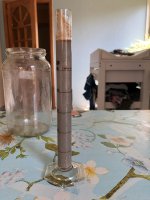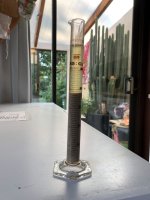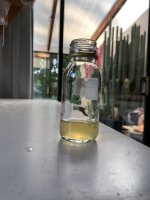Would it interfere with the tannin precipitation to simply dissolve the plant material in significantly more liquid but with the same amount of lime? From previous posts it seems that tannin content rather than amount of liquid is what determines how much lime is needed. In this way, there might be much less DMT trapped in the lime layer?
EDIT: In previous posts you've suggested that vodka > higher % ABV liquids because tannins might more easily redissolve in the latter, but would less alcohol and more water interference with lime precipitation? Asking in the context of the idea of increasing the volume to avoid a lot of DMT trapped in the lime layer.
After the lime step, one then could reduce the volume of the purified product on low heat on the stove to get it down to a desireable volume?
Good thinking! Because of rinsing the plant material with more vodka the initial volume was kept lower (and there were also intrinsic limitations based on the glassware available). The lime precipitate was similarly rinsed so the resulting questions become - how much solvent is acceptable at the end of the process, and how dilute is too dilute?
I see you take care of the latter question in proposing an evaporation step, although those who have the capacity to do so would recover the solvent through distillation. Having to drink five shots' worth of vodka to get a sufficient dose of extract, for example, sounds somewhat excessive to me. It therefore makes sense to evaporate down if the aim is to produce a liquid extract for direct consumption.
During the evaporation process, the alcohol would tend to volatilise preferentially, so I wonder if there might come a point where the freebase alkaloids might start to precipitate. It would be exciting to be able to obtain a solid precipitated extract by cooling the partially evaporated solvent. If this works out, it will be time to branch off this method into its own thread. [This was a roundabout way of addressing the question about lower %ABV solvent - there is a yet-to-be-established lower limit where the solubility of DMT becomes too poor, and the lime precipitation would then co-occur with DMT. In such and instance, the DMT could still be recovered with a higher %ABV rinse.]
While one further intention was to avoid additional heating of the extract, this may not be a relevant factor since the initial extraction involved heating to 60°C, although evaporating vodka could involve temperatures ranging up to 90°C or so. In the one experiment, the initial volumes of solvent were minimised on account of the experimental intention of replicating the vodka freeze-precipitation/oiling out observation without having to perform a concentration step. Of course, this proceed rather differently than the plan since a whole lot of ice crystals formed instead (the formation of additional water during the lime treatment had been overlooked).
The desire to avoid slow and cumbersome filtration is quite understandable. Rather than using a large volume of solvent right from the start, the rinses could be carried out in the settling jar whereby the settling out of solids should, with any luck, be quicker than a filtration. Future experiments will likely be carried out after this pattern since filtering the lime precipitate was, indeed, far too slow.







